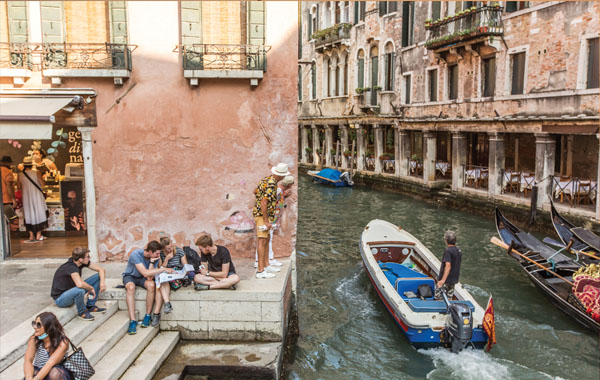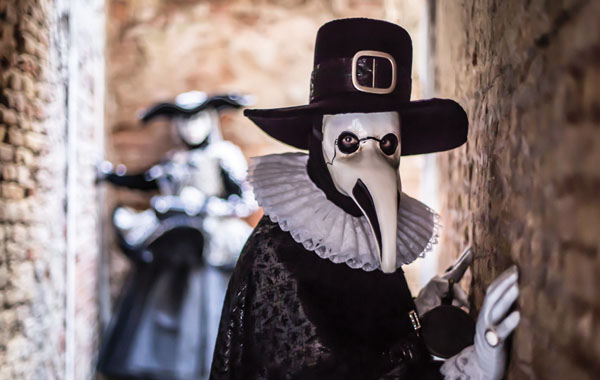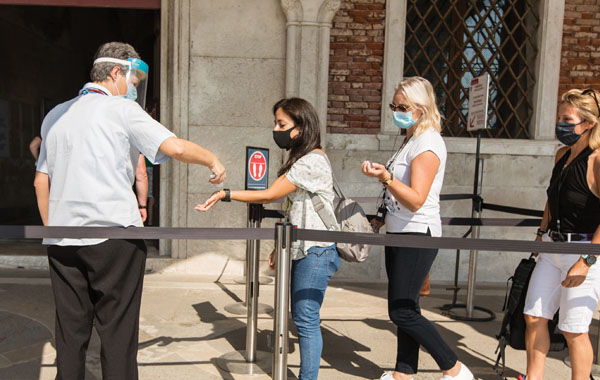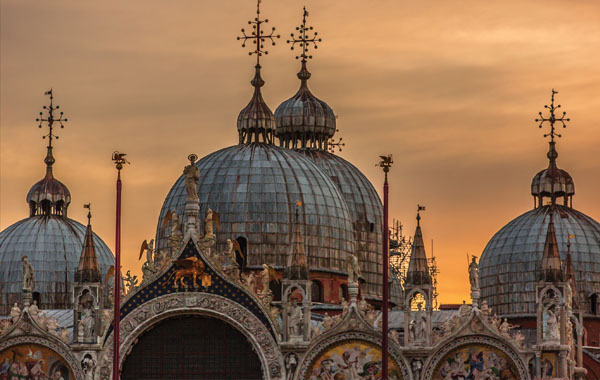Venetian Sara Scarpa takes a look at the city’s cultural re-emergence after the long Covid-19 lockdown and considers what the future holds…
Photos by Sara Scarpa unless otherwise stated

Stopping for a spritz at the foot of Rialto Bridge; Enjoy Respect Venezia is the slogan of the city’s awareness campaign for sustainable tourism; the tourists have returned, but not in numbers; a room with a view; a message of hope; masked resident; tourist on Rialto Bridge; a Plague Doctor costume at the Carnival; terrace at the Osteria Bancogiro
Harlequin, in his colourful chequered costume, and an elegant Venetian nobleman of the 18th century, holding hands with his wife and accompanied by a toddler dressed as the winged lion of Saint Mark’s throwing multi-coloured confetti, stand together in the picturesque Campo della Bragora. Then suddenly, from the end of a dark calle, a sinister figure holding a long stick approaches the square. He is wearing a black tunic, boots, gloves, a wide-brimmed hat and an elaborate white beaked mask with round glasses. Now one of the most recognisable masks of the Venetian Carnival, the Plague Doctor was once a real doctor visiting people struck by plague. The large, protruding beak of his mask was filled with various fragrances to stave off the foul odour of the sick, which was believed to be the trigger of the infection.
It is one of the last days of the Venice Carnival. The annual festival, which usually attracts around three million visitors, was turned on its head in 2020. The city had been busy, but the visitors were fewer than normal and there was a slightly anxious edge to the usually joyful and carefree carnival mood. Walking through the city you could spot the traditional costumes, elaborate masks and beautiful velvet gloves; however, there was a new accessory everywhere you looked. As well as a blue surgical mask, or a scarf to cover the face, velvet gloves had been replaced with disposable ones. They still threw colourful confetti in the air, but this act was followed by antibacterial gel being passed round like bottles of wine – it felt surreal.
Many locals have seen the huge drop in visitors as an opportunity to reclaim their city
As the number of cases of Covid-19 in Italy skyrocketed, the cheerfulness of Carnival was swept away and people’s fear of contagion shot up. By the end of February, especially in the north and centre of Italy, the number of cases of infection continued to rise, with Lombardy the worst affected region, followed by Emilia-Romagna, Piedmont and then Veneto. It was clear that drastic measures had to be taken in order to prevent the spread of the virus: all public gatherings had to be banned.
TAKING STEPS

The President of Veneto, Luca Zaia, took the difficult but correct decision to cut short the Carnival by two days before Martedì Grasso (Fat Tuesday), the grand finale of the traditional annual celebrations. It was another blow to the Venetian economy, devastating but necessary, after the series of exceptional floods that had inundated the city in November 2019 – due to a combination of high tides and strong wind, there had been 12 episodes of acque alte above 110 centimetres in just one month, a record never seen before, and three high tides above 150 centimetres, another record within the last 50 years. Now Venice, like the rest of the world, had to face the terrible pandemic of Covid-19 and the city was unprepared.
On the 9th of March the Italian government imposed a national quarantine restricting the movement of the population, a move considered to be the largest suppression of constitutional rights in the history of the republic, but unfortunately inevitable. For over two months people were allowed to leave their houses only for work, necessity and health circumstances. Everyone was obliged to fill out a self-certification every time they left their house to state the reason, and the start and end point of their journey. Commercial and retail businesses had to be closed, with the exception of essential goods sellers and banks. Masks and gloves or antibacterial gel were compulsory, even in outdoor spaces, and sold out within a few days.
QUARANTINE
The word ‘quarantine’ has been the buzz word of the pandemic, and the term actually originated here in Venice. It was here in this city, many centuries ago, that the first quarantene were introduced. The term was used by Venetians in their successful attempts to prevent the Black Death from spreading during the 14th and 15th centuries. It derives from quarantena, meaning “forty days” (quaranta giorni), and was the period for which ships arriving in Venice during the Black Death plague epidemic were required to wait in isolation before being allowed to enter the heart of the city.
Thanks to this latest, 21stcentury, quarantine many lives have again been saved, but the lockdown has also crushed the tourist trade, leaving hotels and restaurants empty and causing thousands of Venetians to be laid off. In fact it has negatively affected most businesses in the city, as around 25,000 Venetians are directly employed in tourism and many more rely on the industry indirectly.
Venice was deserted for over two months: no crowds in Saint Mark’s Square; no queues for the Doges’ Palace; nobody taking selfies on Rialto Bridge – unheard of in modern times. This was terrible for business but good for the environment. For a few months nature reclaimed the city. The only visitors to the piazze were the pigeons; and the aquatic life of the lagoon was revealed – with no large cruise ships and no heavy traffic, the sediment stayed at the bottom of the canals, so the water was much clearer and schools of fish were visible in the canals. Without the moto ondoso (the wave movement) the Bacino di San Marco resembled a large mirror and the reflections of palaces on the Grand Canal created wonderful paintings on water. More generally, there has been a decrease in noise pollution and a great improvement in air quality.
Many locals have seen the huge drop in visitors as an opportunity to reclaim their city and find a way to think of a more sustainable economy by focusing on creating a city where not everything revolves around tourism. For many years the numbers of residents has been falling steeply; the population of the historical centre has shrunk to just over 51,000. Now Venetians are demanding more properties be made available for residents at affordable prices, with more services and more sustainable businesses, rather than just Airbnb and tourist trap shops.
OPENING UP

Finally, after months of restrictions, Venice seems to be getting back to a sense of normality. Gradually shops and businesses have reopened; first bookshops, stationeries and children’s clothing then other businesses, restaurants, bars and finally museums. Even though all businesses still have to follow strict regulations to prevent the contagion, the city seems to begun its rebirth just like La Fenice (The Phoenix); the major opera house in the city repeatedly destroyed over the centuries, which has always risen triumphantly from its ashes.
After a very strict lockdown, we can again meet over drinks and long, drawn-out
One area that continues to divide opinion is cruise ships and how to manage that challenge if and when they return to the lagoon. Italy lifted its restriction on movement in early June, and Venice has seen more visitors, first from neighbouring regions, then from nearby countries and, recently, with flights more available, from abroad.
THE NEW NORMAL?

Venice is gradually getting busier. The public boats are often crowded with hundred of masked commuters; the markets are full of shoppers; small queues are seen outside the main museums; and restaurants and hotels have seen a considerable increase in the number of guests. It is all tentatively moving in the right direction. And of course, family gatherings are frequent and meaningful again. After a very strict lockdown, compared to the UK, we can again meet over drinks and long, drawn-out meals.
In a small city like Venice where vast restaurants and spacious shopping centres are unknown and the norm is small on a big scale, social distancing could have been a real problem with traditional Venetian osterie and bars. Luckily however, Venice is a car-free city and the pleasant and constant weather plays its part as many areas offer outdoor spaces to enjoy a drink and a cicchetto while maintaining social distancing. Cannaregio with Fondamenta Misericordia and Zattere overlooking the Canale della Giudecca are among the best places where you can enjoy a drink and food on the embankment while taking in the view.
Venice is gradually getting busier. The public boats are often crowded with masked commuters; the shoppers returning to the markets…
The lack of people has its advantages. It is unusual to be able walk at this time of the year in the centre of the city without having to slalom past vast crowds of tourists, and to be able to pause to admire the fascinating details that make the city so beautiful and unique. The ancient patere on the façades of the palaces, the hundred representations of lions around the city, the elaborate doorknobs and the hidden symbols are waiting to be discovered.
Hotels and other accommodation are more affordable and, with fewer crowds, you are freer to enjoy the city’s museums and wonderful exhibitions at your leisure. You can avoid the long queues at the main museums; you can take time turning your gaze upwards to contemplate the more than 8,000 square metres of glittering mosaics covering the walls, vaults and cupolas of Saint Mark’s Basilica, or to rest your neck while looking down at its mosaic floors made of precious polychrome marble; you can pause to admire the great works of art by Titian, Veronese, Tintoretto and Tiepolo in the Doges’ Palace.
As winter apporaches, we have made good progress in finding a new normal in Venice
LOOKING FORWARD

Huge efforts have been made to relaunch the economy. Events, exhibitions and celebrations have been planned for the near and distant future. Some have already taken place, with great appreciation from visitors and locals alike. Many residents who were determined to reclaim a quiet city devoid of tourists have now realised that without visitors Venice would die.
As the beaches close across the lagoon and winter arrives, we have made good progress in finding a new normal in Venice – not one we are content with, but one that we must continue to navigate in the changeable coming months. If you do visit Venice, please remember you too have a valuable part to play in this fragile city’s recovery.
